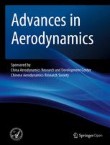- Adv. Aerodyn. ranks 7/40 (Q1) in PHYSICS, FLUIDS & PLASMAS in the 2024-released JCR
- Journal Metrics 2023
- Top Downloaded and Most Cited Articles Published in 2023 and 2022
- Previous Featured Articles
Journal Updates
Collection
Kinetic Methods for Multiscale Flows: In Memory of Dr. Peng Wang
This collection aims to honour Dr. Peng Wang’s contributions to the field in which he worked and provide readers with a glimpse of the exciting ongoing research in the field.
The collection includes five papers by leading experts in the field, covering topics such as a three-dimensional high-order compact GKS, an adaptive DUGKS for all flow regimes, a DUGKS for multiphase flows, a DUGKS for gas mixture flows, and an accelerated low-variance DSMC by GSIS.
Featured Article
WCNS schemes and some recent developments
Weighted compact nonlinear schemes (WCNS) are a family of nonlinear shock capturing schemes that are suitable for solving problems with discontinuous solutions. The schemes are based on grids staggered by flux points and solution points, resulting in algorithms with the nonlinear interpolation step independent of the difference step. Thus, only linear difference operators are needed, such that geometric conservation law can be preserved easily, resulting in the preservation of freestream condition. In recent years, these schemes have attracted a lot of attention in the community of computational fluid dynamics. This paper intends to give a brief review of the basic algorithms of these schemes and present some related recent developments.
Experimental design for a novel co-flow jet airfoil
The Co-flow Jet (CFJ) technology holds significant promise for enhancing aerodynamic efficiency and furthering decarbonization in the evolving landscape of air transportation. The aim of this study is to empirically validate an optimized CFJ airfoil through low-speed wind tunnel experiments. The CFJ airfoil is structured in a tri-sectional design, consisting of one experimental segment and two stationary segments. A support rod penetrates the airfoil, fulfilling dual roles: it not only maintains the structural integrity of the overall model but also enables the direct measurement of aerodynamic forces on the test section of the CFJ airfoil within a two-dimensional wind tunnel. In parallel, the stationary segments are designed to effectively minimize the interference from the lateral tunnel walls. The experimental results are compared with numerical simulations, specifically focusing on aerodynamic parameters and flow field distribution. The findings reveal that the experimental framework employed is highly effective in characterizing the aerodynamic behavior of the CFJ airfoil, showing strong agreement with the simulation data.
-
-
Effect of tip clearance on non-synchronous propagating flow disturbances of compressor rotors under high aerodynamic loading conditions
-
Direct numerical simulation of supersonic boundary layer transition induced by gap-type roughness
-
Numerical study on the thermodynamic behavior of de-icing liquid droplets impacting walls
-
The characteristics and corrections of ventral support interferences in the transonic-speed wind tunnel for the blended-wing-body aircraft
Aims and scope
Advances in Aerodynamics (AIA) is aimed to report the scientific and technological advances in aerodynamics from the aspects of academic research, industrial development, and engineering applications; and to provide a platform for ideas exchange and discussion in this fast-changing field. The journal welcomes reviews and regular papers of novel studies on aerodynamic science and engineering. The topics include but are not limited to:
- Theoretical and Computational Aerodynamics
- Equilibrium and non-equilibrium flow
- Numerical method and validation
- Turbulent flow modeling and simulation
- Multiple physical field simulation
- Experimental Aerodynamics
- Wind tunnel experiments
- Propulsion and combustion
- Flow visualization
- Measurement and control techniques
- Wind Engineering and Industrial Aerodynamics
- Buildings and bridges
- Automobiles and high-speed ground vehicles
- Renewable energies
- Environmental wind engineering
- Related Cross-disciplinary Aerodynamics
- Aeroacoustics
- Aero-optics
- Aeroelasticity
- Aerodynamic stealth
Message from the Editors-in-Chief
On behalf of the editorial board, we are honored to announce the launch of a new journal, Advances in Aerodynamics (AIA), and we are very pleased to share with you our vision for the development of this journal. AIA is an international peer-reviewed open access journal which publishes high quality papers with originality, novelty, and significant contributions to the progress in aerodynamics. The journal will provide authors with an open and fair platform to promote their research and identify themselves in the aerodynamics community. Read more.
Affiliated with
-
-
Advances in Aerodynamics is affiliated with the with Computational Aerodynamics Institute, China Aerodynamics Research and Development Cernter and Chinese Aerodynamics Research Society.
Abstracted and Indexed in
Emerging Sources Citation Index
EI Compendex
SCOPUS
TD Net Discovery Service
ProQuest-ExLibris Summon
ProQuest-ExLibris Primo
Portico
OCLC WorldCat Discovery Service
Naver
Google Scholar
EBSCO Discovery Service
Dimensions
DOAJ
CNPIEC
CNKI
CLOCKSS
Astrophysics Data System (ADS)
INSPEC
Annual Journal Metrics
-
Citation Impact 2023
Journal Impact Factor: 2.9
5-year Journal Impact Factor: 2.9
Source Normalized Impact per Paper (SNIP): 1.279
SCImago Journal Rank (SJR): 0.773
Speed 2023
Submission to first editorial decision (median days): 8
Submission to acceptance (median days): 85
Usage 2023
Downloads: 257,747
Altmetric mentions: 13
- ISSN: 2524-6992 (electronic)
- ISSN: 2097-3462 (print)
